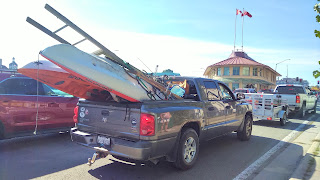A walk in the woods in October, just east of Cumberland, took six of us by surprise. It had been my idea to come here. We knew that sculptures had been installed, but we hadn't anticipated how many of them there would be and of what good quality.
The installation is seasonal (i.e. not viewable in the winter months) and is a project of the Humanics Institute that aims to teach people, without being too dogmatic about it, that the religions of this world have striking similarities. I agree with the implication that one of the things we should all be searching for, in this life, is the vision we have in common:
- [W]hile acknowledging that differences exist, we believe that the commonalities in our religious beliefs, spirituality, race, ethnicity, culture and nationality ultimately unite us.
- [W]hile celebrating diversity, we strive to advance the awareness that we are not fundamentally different from one another.
The elderly gentleman who created this "Sanctuary and Sculpture Park", is Ranjit Perera, President of the Humanics Institute, who's originally from Sri Lanka where some of the sculpture comes from. I assume his upbringing was Hindu. Many of the other pieces are modern imports from Zimbabwe. The site is still under construction with more to come, so the owners hope. The walk around the site, up and down slopes and crossing a stream in a steep valley a couple of times, which we did in the rain with our umbrellas up, encourages a pause at each station where sculptures are placed, and meditation on the three principles common to all religions:
- The Oneness of Reality ... interpreted [variously] as Brahma, or Yahweh, or Buddha the Enlightened One, or God or Allah, or the Great Spirit
- Equality -- All humans are responsible beings, born free and equal in dignity and rights
- Interconnection -- There is an intrinsic relationship between human beings individually and collectively, and the natural and the cosmic environment around them
The phrase I underlined above is frequently repeated on the explanatory boards.
Some of the three-dimensional artworks appear in groups, like the animals (horse, giraffe, elephant, etc.) made from pieces of metal near the driveway, and there are areas where people can gather for a wedding or to learn about the institute under a canvas awning. They had some fruit juice to hand out but to Elva's chagrin on that damp and chilly morning, no coffee. That would have been a touch too secular, perhaps.
We all came away thinking deep thoughts, but also hungry for lunch, so we stopped at a restaurant of good repute in the village of Cumberland with the peculiar name of Maker Feed Co. (it's a former farming supplies store) and were lucky to be seated on very fancy chairs at the only table available, for a posher-than-average brunch.
That place, too, was a worthwhile discovery, rather pricey, but special, in an old stone house with white-painted verandas and balconies. The chef uses locally farmed products in his dishes.



















